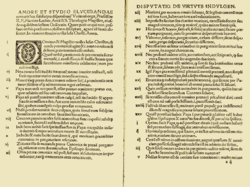Magisterial Reformation
| Part of a series on the |
| Reformation |
|---|
 |
| Protestantism |
The
Roman Catholic Church continued its claim to be the one true church, the churches produced from the Magisterial Reformation have ongoing claims to being a part of the continuation of the Catholic Church as it was and is referred to in the Nicene Creed. There were several denominations looking at different ways to conduct Christian worship and Christian life relative to the Roman Church during this time period. Among these were the Magisterial Reformers and the Radical Reformers
.
The Magisterial Reformation "denotes the Lutheran, Calvinist [Reformed], and Anglican churches" and how these denominations "related to
Anabaptist Churches) rejected any secular authority over the church,[3] the Magisterial Reformation argued for the interdependence of the church and secular authorities, i.e. "The magistrate had a right to authority within the church, just as the church could rely on the authority of the magistrate to enforce discipline, suppress heresy, or maintain order."[2]
In addition, the term
The major reformers representing the Magisterial Reformation were
. The Magisterial Reformers believed that secular authority should be followed, where it did not clash with biblical commands. An example of this was seen in the Peasant’s Rebellion of 1525 which Luther originally supported, but later condemned when it turned violent.[8][9]References
- ISBN 978-1-305-14304-3.
The Magisterial reformation denotes the Lutheran, Calvinist, and Anglican churches; this is sometimes labeled the mainstream of the Reformation. Magisterial means that secular authorities ("magistrates") had a role in the life of the church; church and state were closely tied.
- ^ ISBN 0-63120843-7
- ^ Saint-Clair, Geoffrey (2001), "Who's Who in the Reformation", The Radical Reformation, Catholic education, retrieved 2012-11-17
- ISBN 978-1-316-55285-8.
... where nationally dominant magisterial Protestant churches (Lutheran, Anglican, and Presbyterian) became virtual "departments of state" in their governance, as one Reformation historian characterized them.
- ISBN 978-1-5326-1708-9.
The "magisterial" Protestant denominations (i.e., Lutheran, Reformed, and Anglican) all claimed to honor the ecumenical Councils of the undivided Church and give a modicum of authority to the Church Fathers
- ^ The Gospel Coalition website
- ^ Cambridge University website
- ^ Bloomsbury website
- ^ Socialist Worker website
